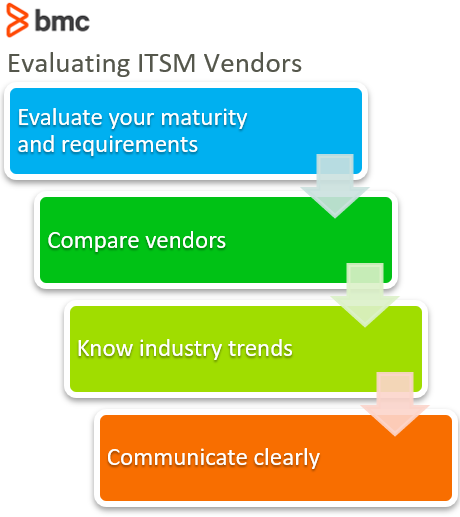The ITSM solutions industry has grown rapidly as organizations seek to align their workforce resources, processes, and technologies with strategic business objectives. Cloud computing and advanced AI technologies have enabled vendors to offer a variety of ITSM capabilities suitable for a range of use case applications across all industry verticals.
For customers, the ability to choose from multiple vendors in a competitive industry sounds promising, but the reality is that making the right choice is difficult. Navigating user reviews and hyped-up branding isn’t the best path. Instead, choosing the right ITSM vendors should be a systematic process that accounts for the current—and future—needs of your organization.
In this article, we’ll discuss a step-by-step approach that you can take for shopping and choosing the right ITSM vendor and tools.

1. Evaluate your requirements and maturity state
The best ITSM solutions and services are designed to meet customer requirements. Before evaluating how available options in the market fulfill this criteria, it’s important to gain an accurate perspective on your infrastructure and operational maturity.
- Create a roadmap of maturity dimensions using models such as the Gartner Infrastructure and Operations (I&O) maturity model. The maturity model can help your organization approach ITSM investments with minimal risk and maximum opportunity to leverage the variety of ITSM functionality.
- Understand your organization’s progression through the maturity journey. Knowing how far or near you are to the future and desired state of maturity can help your organization optimize ITSM ROI. The ability to foresee such a progression prevents you from:
- Investing in expensive advanced ITSM functionality that you’ll never use to its maximum potential.
- Being stuck with ITSM capabilities that restrict rapid business growth and scalability.
- Evaluate your organization’s needs. Don’t start with ITSM. The right approach is to start with the business outcomes you’re trying to achieve, then understanding the ITSM practices that will support them.
Once you’ve identified your true state of I&O maturity, you can classify vendors based on their offered solutions: basic, intermediate, and advanced.
2. Compare vendors
Systematically evaluating ITSM vendors requires you to consider the most insightful, consistent, and relevant metrics. Make sure each comparison is apples-to-apples, driven by data, and performed objectively.
Some common evaluation criteria could be:
- Pricing based metrics. Compare different tiers based on a Total Cost of Ownership (TCO) and progression of pricing tiers based on service consumption.
- Service reliability and dependability. Identify the cost of various SLA tiers, geographic regions of cloud service, known outages, and poor customer experiences.
- Evaluate the variety of services and functionality available. Evaluate how the solutions compare off the shelf, then consider the issues associated with customizing infrastructure and service management technologies. Customizations can be useful to fill in the functionality gap. However, customizations are expensive and restrictive in nature. It may take a lot of time and effort to make customized ITSM solutions work exactly the way you want, but once the requirements change, it may be impossible to adapt and scale customized technologies or to integrate them with new solutions.
- Openness and integrations. How well do the ITSM solutions integrate with your existing infrastructure? How well are legacy technologies supported? How do new technology solutions follow industry standards and integrations with competing products?
- Customer support. How supportive is the vendor to organizations like yours? Obtain real-world references and reviews from their customers in the same ITSM maturity phase, industry vertical, and size. Keep an eye for issues such as vendor lock-in, sharply rising pricing tiers, support delays and issues, and legal disputes, among others.
- Technology hosting. Evaluate ITSM solutions in terms of deployment classifications. Do you need an on-premise or cloud solution? Is the hosting outsourced by the ITSM vendor to a third-party service provider? Might regulatory compliance limitations impact your choice for technology deployment?
- Critical capabilities. Evaluate vendors on the critical capabilities of ITSM technologies they offer. Identify the ITSM capabilities most relevant for your use case and state of maturity. It’s likely that less popular vendors have tightly focused their ITSM offerings, while large vendors excel at a variety of functional domains, though some may not be immediately relevant to your requirements.
- Vendor stability and strategy. ITSM is a long-term project that must evolve and adapt as your organization grows. To that end, the vendor must exist and provide support in the direction of your long-term ITSM growth.
3. Know industry trends
An important consideration when evaluating an ITSM vendor is to understand how the industry is growing—and how vendors are responding to that changing landscape.
- Evaluate how vendors integrate the latest technologies to solve known ITSM problems and use cases.
- Focus on advancements that simplify ITSM frameworks and implementations.
- Understand how the use of AI-based technologies replace manual intervention and simplify the ITSM process from the user and customer perspective.
For instance, the use of AI chatbots aims to simplify service desk support, but how does it fare in practice in terms of service desk metrics such as First Contact Resolution (FCR), resolution time, and customer satisfaction ratings?
Each vendor may have their own approach to integrate AIOps solutions to the ITSM processes and existing technologies, including requirements on how your infrastructure resources and configuration management database (CMDB) is managed. The implementation may have requirements on how your CMDB is modeled, acquires data, and populates real-time dependency information from across your IT environment.
The ability of a vendor to make an AI implementation work without disrupting the ITSM project and cost optimization measures is therefore a key criteria on how well it compares against competing AI-enabled and traditional ITSM technologies.
4. Communicate clearly with vendors
Finally, it’s important to communicate correct requirements through the Request for Proposal (RFP) process. It’s possible that a vendor is fully supportive and capable of addressing your true ITSM requirements within budget and expected timeline, but the vague and inaccurate RFP prevents them from getting the right message across.
BMC is a leading ITSM vendor
BMC helps you run your business as you reinvent it—with software, solutions, and services to help evolve to an Autonomous Digital Enterprise.
BMC Helix is the first and only end-to-end service and operations SaaS platform that’s integrated with 360-degree intelligence. The future of service and operations management. Learn more about BMC Helix.
Additional resources
For more on ITSM tooling, explore the BMC Service Management Blog and these articles:
- The State of ITSM in 2020
- Gartner® Magic Quadrant™ for ITSM
- The Seven ITIL 4 Guiding Principles
- Why Do ITSM Implementations Fail?
- How To Build Your ITSM Business Case (Free Template Included)
- Managing IT as a Product—Not a Project







